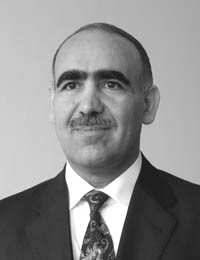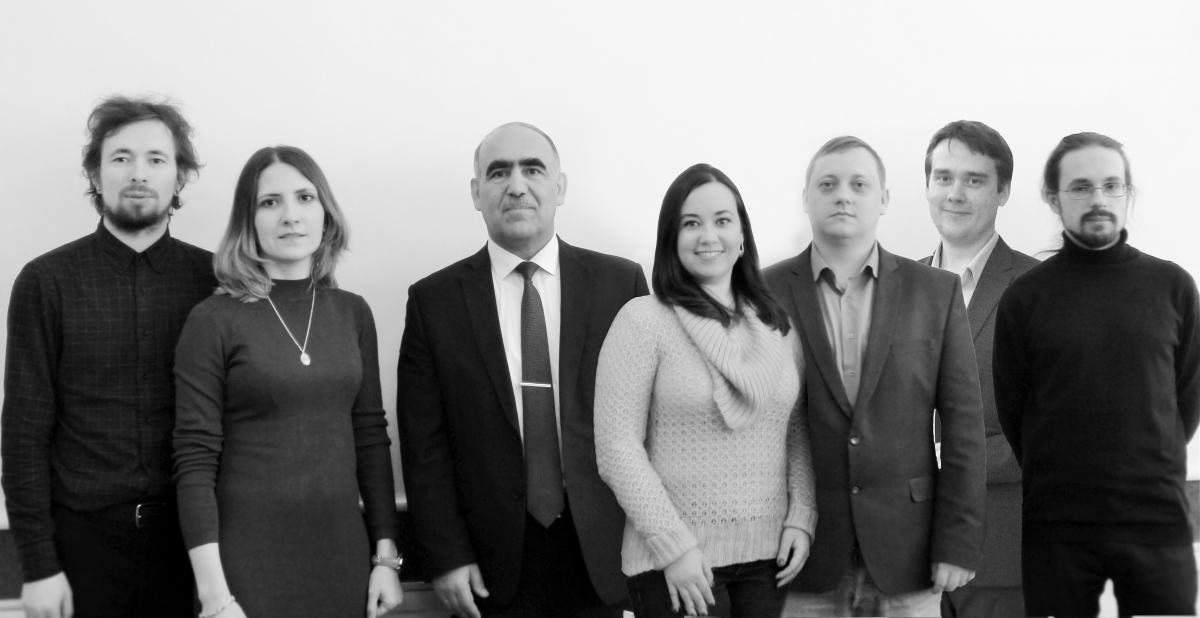AUTOMATED QUEUING SYSTEMS AND SIGNAL PROCESSING
 |
|
Vladimir A. Zhozhikashvili, Founder and first Head of Laboratory No. 17 |
The Laboratory was formed in 1959 from some employees of Laboratory No. 3 (Prof. M.A. Gavrilov). Vladimir A. Zhozhikashvili was appointed Head of the Laboratory. He performed the functions until passing away. Since 2008, Laboratory No. 17 has been headed by Dr. Sci. (Eng.) Mais P. Farkhadov, one of the leading experts in speech technology systems.
R.V. Bilik, E.V. Kartuzov, and V.N. Silaev significantly contributed to the formation and development of the Laboratory.
Research of Laboratory No. 17 was successively developed in the following main areas:
– Non-contact remote control systems (1953–1965);
– Automated queuing systems, the Sirena system and network (1965–1998);
– Applications of speech technologies in information systems, control, and analytics (1998–2008);
– Models and methods of intellectualizing information and service systems based on modern interface and info- and telecommunication technologies (2008–present);
– Background signal processing;
– Robot control.
Non-contact remote control systems
In 1959–1965, led by V.A. Zhozhikashvili, Laboratory’s employees pioneered the creation of non-contact discrete-action elements based on magnetic cores with a rectangular hysteresis loop as an antipode for electromagnetic contact relays. Those elements were used to develop non-contact remote control systems (telecontrol, telemetry, and tele-signaling). They contained no electromechanical contacts and, therefore, had super high reliability. It was a real revolution in remote control and automation, far ahead of the research in other countries. USSR plants mastered mass production of non-contact remote control systems for agriculture, power industry, metallurgy, communications, military industry, etc.
 |
|
Mais P. Farkhadov, Head of Laboratory No. 17 |
Automated queuing systems
In 1965, the Laboratory started developing Sirena, the first system in the USSR for booking and selling Aeroflot flight tickets. Several research institutes, design bureaus, and enterprises of the USSR Ministries of Instrumentation and Civil Aviation were involved in creating the system; the Institute received the status of the leading organization. V.A. Zhozhikashvili, Head of Laboratory No. 17, was appointed the General Designer of the system. The Sirena project was implemented with progressive ideas, which later became fundamental for different-purpose queuing systems. Many problems were solved for the first time in the USSR:
– creating a distributed dynamic database to serve an intensive flow of transactions in real time;
– using input-output terminals with a screen and an alphanumeric keyboard;
– developing a high-reliability data transmission network with packet switching and adaptive routing;
– developing e-mail, including first practical application.
In 1972, the Moscow hub of the Sirena system was put into commercial operation. Within several years, the system was expanded to the entire territory of the USSR, considerably improving Aeroflot’s operation. Sirena was implemented by a special department of the Institute based on Laboratory No. 17, headed by V.A. Kucheruk.
The Sirena project experience was utilized to elaborate a theory of constructing a new class of distributed computer systems with real-time multiaccess to remote databases, called automated queuing systems (AQSs). At that stage, significant contributions to the theory were made by V.L. Bakhrakh, L.B. Belokrinitskaya, R.V. Bilik, V.A. Vertlib, V.M.
 |
|
Valery A. Kucheruk |
Vishnevsky, A.S. Ipatov, E.V. Kartuzov, G.L. Katsman, V.I. Kurbatsky, Z.P. Myasoedova, S.V. Nikiforov, N.V. Petukhova, A.A. Prytov, B.I. Rebortovich, A.L. Rozovsky, A.B. Savinetsky, V.N. Silaev, I.V. Sitnikova, S.I. Spivakovsky, L.M. Starkova, A.S. Tverdokhlebov, B.N. Tereshchenko, V.I. Tyunin, E.V. Fedotov, M.S. Shamova, T.M. Shibaeva, A.V. Shipunov, and M.P. Farkhadov.
Sirena was the first operating queuing system for the population in the USSR, unique in national practice.
Due to progressive scientific and practical solutions underlying the system, Sirena had been steadily developed and improved for many years. The Global Distribution System (GDS) Sirena-Travel and the Transport Automated Information System TAIS CRS (Sirena-2.3) emerged while improving Sirena-2. Both systems mentioned are successfully operating nowadays.
 |
 |
|
The Sirena-2 system networks (1979) |
Sirena's developers from Laboratory No. 17 (V.A. Zhozhikashvili in the center) |
Queuing systems with speech technologies
In 1998, Laboratory’s leading experts (V.A. Zhozhikashvili, R.V. Bilik, N.V. Petukhova, V.A. Vertlib, M.P. Farkhadov, and Z.P. Myasoedova) launched a new project called New-Generation AQSs. The project was intended to make information and service provision cheaper, more open, and accessible to the population. The key role was assigned to computer voice technologies: speech recognition and synthesis, voice identification, and talk spurt analysis. A speech portal with interactive self-service functions and intelligent services can significantly improve the efficiency of service centers.
Rational application areas of speech technologies are almost unlimited. First of all, the Laboratory applies these technologies as a superstructure over the existing AQSs (Sirena, taxi operators, and banking systems) and in innovative projects. For this purpose, universal recognition units were created. They include grammars, dictionaries, and acoustic models for numbers, dates, the time of day, telephone numbers, addresses, cities, etc. Particular scenarios were also developed for booking flight tickets, ordering a taxi, and managing money accounts in a bank. The developed methodology with situational and dynamic dialog control makes the dialog compact and user-friendly.
Applied R & D of the Laboratory
Surdoserver
This project aims at facilitating communication with deaf and hearing-impaired individuals. It has the following features:
- integration with social networks,
- mobile interfaces,
- commercialization.
Speech trainer
This trainer is intended for practicing the correct pronunciation of Russian phones. It has online accessibility.
Physical fitness calculator
- Integration with geolocation services
- Interactive health condition monitor
- Exercise mode management
Sirena
(the system for booking and selling Aeroflot flight tickets)
- Online services
- Voice recognition interface
Besides implementation in queuing systems, speech technologies can be used in other areas:
- voice control of robotic complexes;
- intelligent speech interface for hands-free modes;
- assistance systems for medical personnel;
- talk spurt analysis for business analysts and security systems;
- learning systems based on speech and multimedia technologies, particularly for people with hearing impairments;
- technology, particularly for people with hearing impairments.
Intellectualization models and methods for information and service systems based on modern interface and info- and telecommunication technologies
Laboratory’s current research deals with intellectualization models and methods for modern information and service systems. These R & D works include developing:
- intellectualization principles for information and service systems using up-to-date information, speech, multimodal interfaces, and mobile services;
- network analysis and design methods based on new telecommunication and information technologies;
- a multilevel system of static and dynamic network models;
- a self-consistent model of network systems, including its implementation;
- psychological state assessment methods and software tools for automated queuing system operators to test their professional reliability based on the brain wave model;
- an artificial neural cortex with application to intelligent control, clustering, and image recognition;
- socially-oriented queuing systems;
- Surdoserver, an Internet portal of a socially-oriented queuing system;
- intellectual multimedia learning systems.
Background signal processing
 |
|
Avtandil N. Anuashvili |
In 2013, the Laboratory merged Laboratory No. 26 (Information Perception Systems Based on the Background Principle) headed by Dr. Sci. (Eng.) Avtandil N. Anuashvili.
Laboratory No. 26 was established in 1990 after discovering the law of manifesting the object’s mobility (the background principle). The discovery certificate was issued by a decision of the Department of Mechanical Engineering, Mechanics, and Control Processes, the Russian Academy of Sciences, based on the expert opinion of two academic institutes: Ioffe Institute of Physics and Technology and the Institute for Problems in Mechanics.
Over the years of existence, Laboratory No. 26 has performed nine state orders from the Ministry of Defense and the General Staff of the Russian Federation. New fundamental results were obtained when developing the background principle. In particular, a previously unknown phenomenon—the coherent amplification of the object’s mobility signal—was found. Later on, it underlay the design of a new-generation radar, nowadays known as holographic radar. Note that this radar was implemented in the USA. Holographic radar and background detection and ranging are topics of modern conferences and dissertations on operational control problems.
As established, the background principle is also manifested in the living nature. For example, under natural conditions in the human brain, coherent amplification of the signals on the mobility of objects (sources of electromagnetic oscillations, centers of electrical activity) occurs. In addition, a previously unknown pattern of variations in the human’s psychological type depending on the parameters of electromagnetic oscillations in the brain was found. A previously unknown property of the human’s psychophysiological self-regulation under biological feedback was also discovered. A mathematical signal detection model against a background noise was developed as a theoretical generalization of the background principle.
Research initiated by Laboratory No. 26 successfully continues in Laboratory No. 17. The main area is studying the background principle of signal processing. This research aims to create intelligent information perception systems by generalizing the background principle.
Robot control
Since 2014, the Laboratory has been working on robot control based on recent technical, technological, and scientific achievements. In 2018, Laboratory’s employees participated in creating Malakhit, an underwater vehicle. It received the first prize at the Aquarobotech-2018 competition in the corresponding class of vehicles. The following problems were solved while creating the working model: motion stabilization, using video analytics to help the operator find objects and work with them, and manipulator control.
Laboratory’ employees performed 6 projects under the support of the Russian Foundation for Basic Research and participated in 15 international and domestic scientific and industrial exhibitions. Laboratory’s works were repeatedly awarded diplomas and medals. The Laboratory has a young scientific school. Laboratory’s employees have published over 400 papers and monographs in the recent decade.
 |
|
Prof. Mais P. Farkhadov and some members of his young scientific school |
